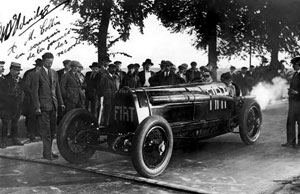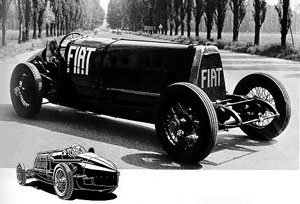Ernest Eldridge facts for kids
Quick facts for kids Ernest Eldridge |
|||||||
|---|---|---|---|---|---|---|---|
| Born | Ernest Arthur Douglas Eldridge 18 July 1897 Willesden, Middlesex, England |
||||||
| Died | 27 October 1935 (aged 38) Kensington, London, England |
||||||
| Champ Car career | |||||||
| 2 races run over 1 year | |||||||
| First race | 1926 Indianapolis 500 (Indianapolis) | ||||||
| Last race | 1926 Sesquicentennial Classic Heat #1 (Atlantic City) |
||||||
|
|||||||
Ernest Arthur Douglas Eldridge (born July 18, 1897 – died October 27, 1935) was a British racing driver. He became famous for breaking the world land speed record in 1924. This was the very last land speed record ever set on a public road.
Contents
Ernest Eldridge's Early Life
Ernest Eldridge was born on July 18, 1897, in Willesden, England. His family was quite wealthy. He went to Harrow School, a famous school. However, he left school early to help during the First World War.
Ernest joined the British Red Cross Society. He also joined the Order of St John of Jerusalem. He might have driven ambulances during the war. Some people think he also served in the French Artillery.
After the war, not much is known about Ernest's life for a few years. He reappeared around 1921 at Brooklands, a famous race track. He was also a pilot and survived a plane crash in 1922. He got his pilot's license in 1923. His license said he was an "Automobile Engineer."
Ernest Eldridge's Racing Career
Ernest Eldridge's early racing days had some challenges. He often used very large racing cars. Many of these cars had airplane engines!
First Race Cars and Successes
In 1921, Ernest first appeared in a rare Isotta Fraschini car. It could go over 90 miles per hour. In 1922, he surprised everyone at Brooklands. He put a huge 240-horsepower Maybach airplane engine into his 1907 Isotta Fraschini car. This car was 20 liters big! It had a tiny body built by Jarvis of Wimbledon. Even though race cars were often huge, this one was a sensation. It won its first race going over 101 miles per hour. But overall, it wasn't very successful. He later sold it to another driver.
Ernest then started driving a 10-liter Fiat car. He had some good wins with it. With the money he earned, he bought a car called Mephistopheles. This car would become very famous.
In October 1923, at Brooklands, Ernest set a new world record. He covered half a mile from a standing start in 23.17 seconds. This was about 77.68 miles per hour.
Breaking the World Land Speed Record
Ernest Eldridge made history on July 12, 1924. He broke the World Land Speed Record in Arpajon, France. He drove the Mephistopheles car at an average speed of 146.013 miles per hour. This was over a flying kilometer. In October 1924, he set another record in Montlhéry, France. He drove 210 kilometers in one hour. At one point, he reached 218 kilometers per hour. This was over 136 miles per hour!
Grand Prix Racing and Injuries
In 1925, Ernest sold the Mephistopheles car. He decided to try Grand Prix motor racing. He designed his own cars called the Eldridge Specials. These cars used Amilcar chassis and Anzani engines. He entered them in many races in 1925 and 1926. This included famous races like the Brooklands 200 and the Italian Grand Prix. He also entered two cars in the 1926 Indy 500 race in the United States. He drove one car himself.
While in the U.S., he tried a Miller 122 car. He was very impressed by it. He raced it in some AAA-sanctioned Indy car races. He raced at Rockingham Park and Atlantic City Speedway. He also raced at Altoona Speedway.
After returning to Europe, he tried to break more records. While attempting speed records around Christmas, his car crashed. The front axle broke, and the car flipped over. Ernest suffered serious head injuries and lost an eye.
Recovery and New Roles
After he recovered, Ernest continued to set records. He used other cars, like a Chrysler. Later, he became the "Record Attempt Manager" for Captain Eyston. This meant he helped Eyston with his record attempts.
In 1929, Ernest and Eyston planned to work together. They wanted to break 750cc world records with a French-built Ratier car. When it was ready for testing, Ernest drove it. Captain Eyston later wrote about how funny it looked. Ernest was not small, and he was sitting in a tiny seat on the car's bare frame. The wind made his clothes puff out!
The Ratier project didn't continue. Instead, the two friends worked on the first-ever MG record car, called EX120. With Eyston driving, this was the first 750cc car in the world to set records over 100 miles per hour. Ernest Eldridge was very important in developing the EX120. He designed a special part for the engine. He also told MG that the car needed a supercharger to go even faster.
Ernest supervised the work to add the supercharger. He was also there at Montlhéry as Eyston's signaller. He would stand on the track with a flag. He would raise or lower it to show Eyston how fast he was going.
Ernest also helped design the Speed of the Wind record breaker. This car had a Rolls-Royce engine. He went to Bonneville to manage its record attempt.
Ernest Eldridge caught pneumonia while returning from a trip to Bonneville. He sadly died from it in Kensington. He was 38 years old. Ernest was known as a very lively person. He spent his family's money on racing and flying.
World Land Speed Record 1924
- Speed over 1 kilometer: 146.01 miles per hour (234.98 km/h)
- Speed over 1 mile: 145.89 miles per hour (234.79 km/h)
- Driver: Ernest A. D. Eldridge
- Car: FIAT Special Mephistopheles II (Mefistofele)
- Date: July 12, 1924
- Place: Arpajon, France
- Engine: Fiat A.12
- This was the last land speed record set on a public road.
Motorsports Career Results
Indianapolis 500 Results
|
|
|||||||||||||||||||||||||||||||||||||||||
See also
- Land speed record



